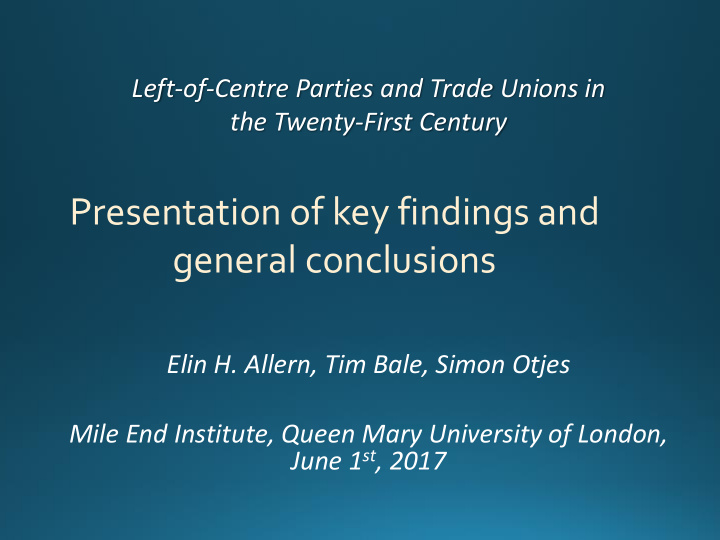



Left-of-Centre Parties and Trade Unions in the Twenty-First Century Presentation of key findings and general conclusions Elin H. Allern, Tim Bale, Simon Otjes Mile End Institute, Queen Mary University of London, June 1 st , 2017
Statutes of all organizational units, other relevant organizational documents and reliable secondary sources. Identical (inverted) questionnaires sent to carefully selected key informants in both parties (CPO and LPG) and the union confederations. Challenge: missing answers despite high response rate and diverging party-union responses regarding organizational facts in some cases. Use ‘ coded expert judgments ’ based on survey and multiple sources in cases of missing and divergence.
05.06.2017 3
Calculated combined link values for both faces of each party (CPO and LPG); i.e. N reduced to 81. ‘ Mokken scaling’ (suitable for dichotomous variables): we test whether pairs of parties and trade unions that have unusually strong links also enjoy the weaker links that occur in many party-union relationships . Scaling results are strong at the transnational level: create an additive overall score of ‘organizational closeness’. A low score: only weak (common) ties, the highest scores: both weaker (common) and strong (less common) ties. Possible to assign index scores to 66 party-union dyads (of 81).
05.06.2017 6
Focus on the the major left-of-centre parties and their traditional allies in the union movement (chapter 16). Summarize country study results and compare party-union cases in different countries: Qualitatively over time, in light of developments in relevant structural variables and party-union resources. Main part: cross-sectional statistical analysis one-level, and bivariat not multivariat, due to limited N of countries and party/unions
05.06.2017 8
Support for the resource exchange perspective but is the relationship between left-of-centre parties and trade unions is essentially lopsided? BUT: Need for better data for a few independent variables? BUT: Need for further research/data on «policy proximity», «policy rewards» (and the competition on both sides), and to og further back in time as far as party resources go? Future research should, if possible, take more countries and parties into account, and look more closely at the connection with party policy and policy outputs.
That said, this study has, we hope, taken us a significant step forward, by documenting that while left-of-centre parties and trade unions may not be as close as they once were, ‘there are few countries in which we could say they may as well be strangers’. 05.06.2017 11
Recommend
More recommend